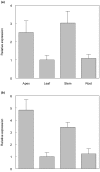The Populus Class III HD ZIP transcription factor POPCORONA affects cell differentiation during secondary growth of woody stems
- PMID: 21386988
- PMCID: PMC3046250
- DOI: 10.1371/journal.pone.0017458
The Populus Class III HD ZIP transcription factor POPCORONA affects cell differentiation during secondary growth of woody stems
Abstract
The developmental mechanisms regulating cell differentiation and patterning during the secondary growth of woody tissues are poorly understood. Class III HD ZIP transcription factors are evolutionarily ancient and play fundamental roles in various aspects of plant development. Here we investigate the role of a Class III HD ZIP transcription factor, POPCORONA, during secondary growth of woody stems. Transgenic Populus (poplar) trees expressing either a miRNA-resistant POPCORONA or a synthetic miRNA targeting POPCORONA were used to infer function of POPCORONA during secondary growth. Whole plant, histological, and gene expression changes were compared for transgenic and wild-type control plants. Synthetic miRNA knock down of POPCORONA results in abnormal lignification in cells of the pith, while overexpression of a miRNA-resistant POPCORONA results in delayed lignification of xylem and phloem fibers during secondary growth. POPCORONA misexpression also results in coordinated changes in expression of genes within a previously described transcriptional network regulating cell differentiation and cell wall biosynthesis, and hormone-related genes associated with fiber differentiation. POPCORONA illustrates another function of Class III HD ZIPs: regulating cell differentiation during secondary growth.
Conflict of interest statement
Figures







Similar articles
-
The Populus class III HD ZIP, popREVOLUTA, influences cambium initiation and patterning of woody stems.Plant Physiol. 2011 Mar;155(3):1214-25. doi: 10.1104/pp.110.167007. Epub 2010 Dec 29. Plant Physiol. 2011. PMID: 21205615 Free PMC article.
-
Thermospermine levels are controlled by an auxin-dependent feedback loop mechanism in Populus xylem.Plant J. 2013 Aug;75(4):685-98. doi: 10.1111/tpj.12231. Epub 2013 Jun 13. Plant J. 2013. PMID: 23647338
-
Chimeric repressor of PtSND2 severely affects wood formation in transgenic Populus.Tree Physiol. 2013 Aug;33(8):878-86. doi: 10.1093/treephys/tpt058. Epub 2013 Aug 11. Tree Physiol. 2013. PMID: 23939552
-
Modeling transcriptional networks regulating secondary growth and wood formation in forest trees.Physiol Plant. 2014 Jun;151(2):156-63. doi: 10.1111/ppl.12113. Epub 2013 Oct 21. Physiol Plant. 2014. PMID: 24117954 Review.
-
Class III HD-ZIPs govern vascular cell fate: an HD view on patterning and differentiation.J Exp Bot. 2017 Jan;68(1):55-69. doi: 10.1093/jxb/erw370. Epub 2016 Oct 7. J Exp Bot. 2017. PMID: 27794018 Review.
Cited by
-
Single-nuclei transcriptome analysis of the shoot apex vascular system differentiation in Populus.Development. 2022 Nov 1;149(21):dev200632. doi: 10.1242/dev.200632. Epub 2022 Oct 17. Development. 2022. PMID: 36178121 Free PMC article.
-
Over-expression of AQUA1 in Populus alba Villafranca clone increases relative growth rate and water use efficiency, under Zn excess condition.Plant Cell Rep. 2016 Feb;35(2):289-301. doi: 10.1007/s00299-015-1883-9. Epub 2015 Oct 30. Plant Cell Rep. 2016. PMID: 26518428
-
The role of HD-ZIP III transcription factors and miR165/166 in vascular development and secondary cell wall formation.Plant Signal Behav. 2015;10(10):e1078955. doi: 10.1080/15592324.2015.1078955. Plant Signal Behav. 2015. PMID: 26340415 Free PMC article. Review.
-
Current Understanding of the Genetics and Molecular Mechanisms Regulating Wood Formation in Plants.Genes (Basel). 2022 Jun 30;13(7):1181. doi: 10.3390/genes13071181. Genes (Basel). 2022. PMID: 35885964 Free PMC article. Review.
-
Genome-wide identification of auxin-responsive microRNAs in the poplar stem.Genes Genomics. 2023 Aug;45(8):1073-1083. doi: 10.1007/s13258-023-01385-7. Epub 2023 Jun 19. Genes Genomics. 2023. PMID: 37336805
References
-
- Groover A, Nieminen K, Helariutta Y, Mansfield SD. Wood formation in Populus. 2010. in, Genetics and Genomics of Populus Jansson, Bhalerao, and Groover (eds) Springer.
-
- Larson PR. The Vascular Cambium. 1994. Springer-Verlag.
-
- Groover AT. What genes make a tree a tree? Trends in Plant Science. 2005;10:210–214. - PubMed
-
- Spicer R, Groover A. The evolution of development of the vascular cambium and secondary growth. New Phytol. 2010;186:577–592. - PubMed
Publication types
MeSH terms
Substances
LinkOut - more resources
Full Text Sources
Molecular Biology Databases

